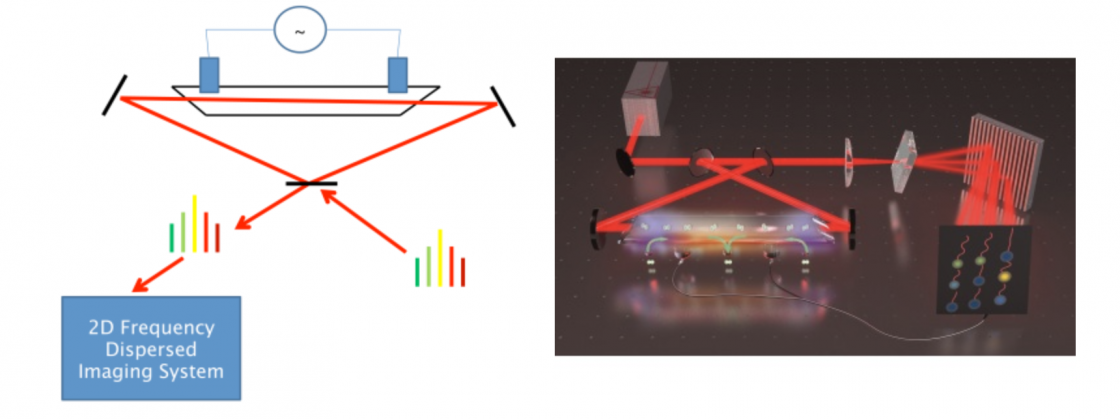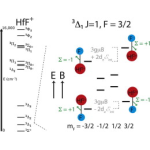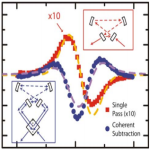Massively Parallel Direct Frequency Comb Velocity Modulation Spectroscopy
Members
Laura Sinclair, Kevin Cossel, Dan Gresh, Jun Ye, and Eric Cornell
Motivation
The Ion Trapping Experiment is attempting to measure the electron EDM by performing precision spectroscopy on the energy shifts of trapped HfF+ in an electric field. Unfortunately, the electronic structure of HfF+ has never been measured. This experiment attempts to solve this problem by presenting a scheme to quickly and easily take spectra of molecular ions with a bandwidth of 10s of nm. In addition to the direct benefit the spectra of HfF+ and ThF+ will have to the electron EDM experiment, spectroscopy of molecular ions could potentially be used to assign currently unassigned absorption lines of interstellar gas.
Apparatus
A diagram of the apparatus is pictured below. A frequency comb is aligned through our science cavity so that each tooth of the comb is matched to a mode of the cavity. In the cavity we drive a 1kV, 100mA discharge at 10kHz to create the ions. The light on the output of the caivty is sent through a VIPA and a grating so that the light is dispersed in two spatial dimensions. We then focus each comb tooth individually onto a separate pixel of a camera, and perform lock in detection on each individual comb tooth to the 10kHz ion modulation signal.

Paper Abstracts
Broadband velocity modulation spectroscopy of HfF+: Towards a measurement of the electron electric dipole moment
Precision spectroscopy of trapped HfF^+ will be used in a search for the permanent electric dipole moment of the electron (eEDM). While this dipole moment has yet to be observed, various extensions to the standard model of particle physics (such as supersymmetry) predict values that are close to the current limit. We present extensive survey spectroscopy of 19 bands covering nearly 5000 cm^(-1) using both frequency-comb and single-frequency laser velocity-modulation spectroscopy. We obtain high-precision rovibrational constants for eight electronic states including those that will be necessary for state preparation and readout in an actual eEDM experiment.
Chem. Phys. Lett. 546, (2012) arXiv
Frequency Comb Velocity-Modulation Spectroscopy
The application of optical frequency combs to a variety of spectroscopic techniques has resulted in ultrahigh sensitivity systems with simultaneous high resolution, absolute frequency accuracy, and spectral bandwidth, all with dramatic reduction in data acquisition times. Prior to this Letter, no techniques have been capable of high-sensitivity modulation spectroscopy on every parallel detection channel over a broad spectral range. We have accomplished this by combining cavity-enhanced direct frequency comb spectroscopy with velocity-modulation and concentration-modulation spectroscopy, demonstrating a new technique that provides massively parallel comb spectroscopy sensitive specifically to ions and radicals. As a test of this system, we have measured the documented A$^2\Pi_u$-X$^2\Sigma_g^+$ (4,2) N2 band and achieved a fractional absorption sensitivity of 10$^{-6}$ recorded over 1500 simultaneous channels spanning a 150 cm$^{-1}$ bandwidth, corresponding to $2\times10^{-7}$ Hz$^{-1/2}$ (spectral element)$^{-1/2}$ absorption sensitivity. A fully sampled spectrum with 75 MHz spacing consisting of interleaved measurements is acquired in under an hour. By resolving individual comb modes, we currently have an absolute frequency accuracy of 30 MHz (0.001 cm$^{-1}$) and could reach below 1 MHz. In addition, several possibilities exist for significantly increasing the sensitivity. This technique has many potential applications in precision measurement, astrochemistry, and physical chemistry.
Rev. Lett. 107, 093002 (2011) arXiv





